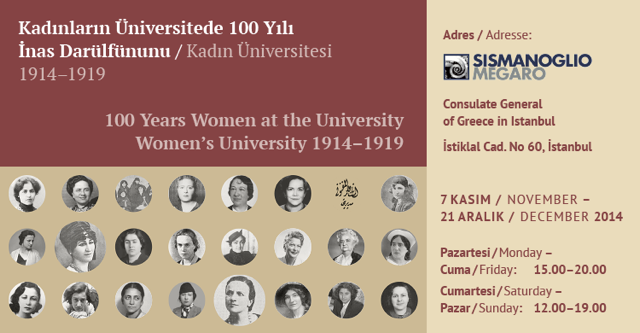24/11/2014
In celebration of the centenary of women gaining the right to university education in Turkey, Sabancı University Gender and Women’s Studies Forum in association with the Women’s Museum Istanbul will hold the Gender Equality in Academia: International Best Practices Symposium between November 6th and 8th, 2014 at the Karaköy Minerva Palas to discuss policies, programs and best practices for gender equality in universities on an international level.
As part of the symposium, an exhibition titled “100 Years Women at the University Women’s University 1914–1919” will be available for viewing between November 7th and December 21st at the Consulate General of Greece in İstanbul - Sismanoglio Megaro.

International examples to be discussed
Women in Turkey acquired the right to receive university education 100 years ago. Today, women question how close we are to achieving gender equality in university, and the level of presence or non-presence of women in academic areas of study. The quality of universities is determined by the quality of the education they give as well as achieving gender equality in academia and particularly the institutionalization of such equality measures.
The Gender Equality in Academia: International Best Practices Symposium will discuss programs, strategic concepts and successful practices developed in universities in Italy, Austria, Germany, Switzerland, Norway, UK, Sweden, France and the United States to ensure gender equality and diversity. The Turkish examples of gender equality programs implemented in Ankara University, Mersin University and Sabancı University will be examined. Concepts developed by the foreign counterparts of TÜBİTAK to ensure gender equality in academia will be studied.
The opening lecture of the symposium will be given by political scientist Şirin Tekeli, who is a leading activist of the second-wave feminist movement in Turkey in the late 1980s. The closing lecture will be given by anthropologist Emily Martin from New York University.
The symposium will attempt to redefine university quality based on the gender factor, and is expected to contribute to the processes in Turkey to establish mechanisms for implementing, institutionalizing and protecting gender equality and diversity in Turkish universities, and towards making permanent, systemic changes in university policies.
The exhibition witnesses a historical process shaped by women
The exhibition titled “100 Years Women at the University Women’s University 1914–1919” presented by the Women’s Museum Istanbul accompanying the symposium sheds light on the story of women gaining access to university, the role played by the Kadınlar Dünyası (Women’s World) magazine, the demands for higher education voiced in the magazine, the methods employed by women to acquire the right to higher education, women’s allies in their endeavors, and the Women’s University experience. The exhibition is a witness to a historical process shaped by women.
The issue of gender equality in academia is expanded to include diversity based on examples from the academic and administrative careers of women. A call is made to think on how close the current situation is to achieving gender equality and diversity in universities after a century of women acquiring the right to university education.
The exhibition and symposium were designed as part of the “Women’s Cultural Heritage” Program of the Women’s Museum Istanbul. The Women’s Cultural Heritage Program describe the cultural legacy of the “firsts” portrayed in the permanent exhibition of the Museum, and investigates the significance of the cultural legacy on the present day. The meaning of women’s cultural heritage is the subject of interdisciplinary studies through international conferences, panels and symposia.
History of women in university in Turkey
Women acquired the right to study at the university in the Ottoman Empire on September 12th, 1914. This was very closely related to the Kadınlar Dünyası (Women’s World) magazine, which is considered the grandmother of today’s feminist journals. Kadınlar Dünyası was issued by Nuriye Ulviye, who used her personal resources, and a group of women’s rights activists from April 4th, 1913 to May 21st, 1921. Through the magazine, women developed policies for acquiring rights in education and employment, implemented tangible projects for women’s solidarity, and started businesses for women.
Reminding that “We too pay taxes for education,” the authors of Kadınlar Dünyası defined women’s right to education as one of their inalienable rights. They escalated their demands for higher education to intellectual and political authorities. They monitored the strategies of state politics concerning education.
Kadınlar Dünyası started a campaign to demand university education for women, and the campaign was supported by women of all strata. Discussions in the magazine and effective lobbying efforts led to the first conferences for women in the history of the Darülfünun (present-day Istanbul University) on February 7th, 1914. These conferences were the first step towards university education for women in Turkey. On September 12th, 1914, the İnas Darülfünunu (Women’s University) for letters and natural sciences was opened in the Mansion of Ms. Zeynep, where the Faculty of Science and Letters stands today.





